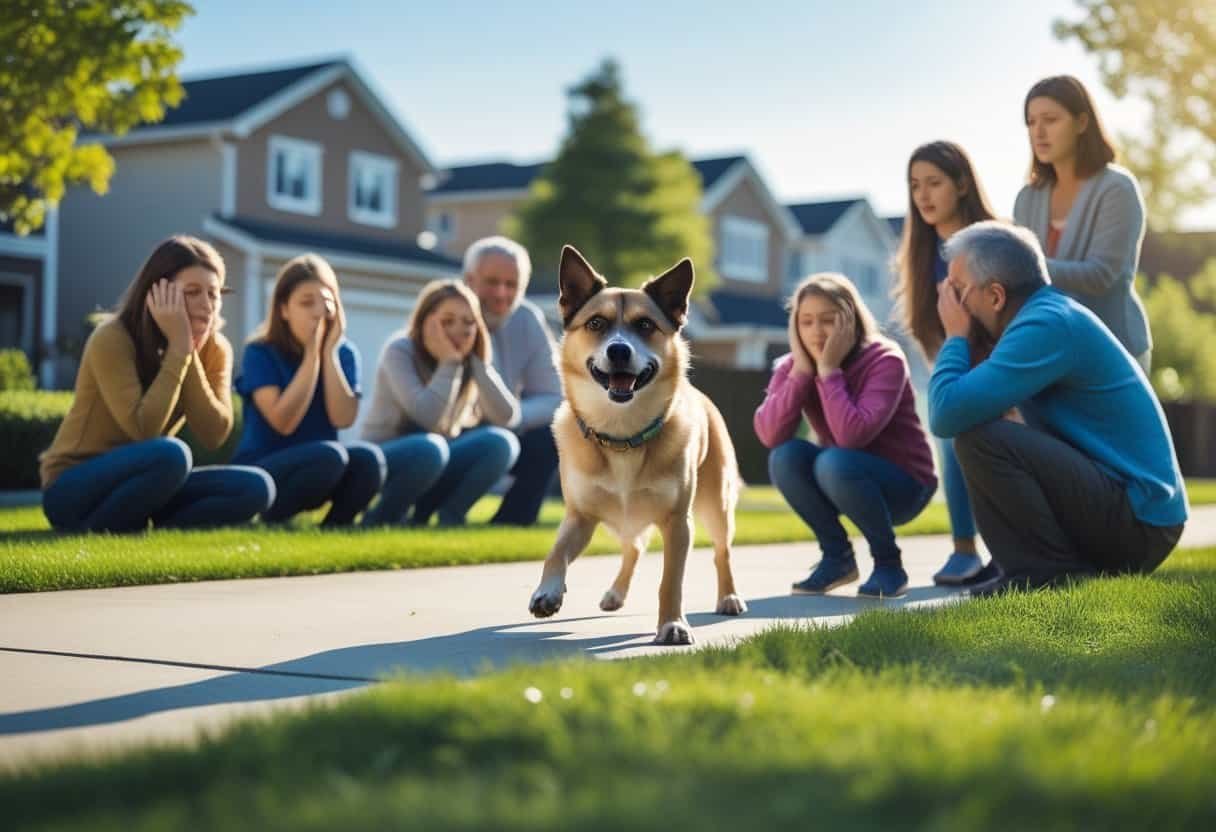
Understanding Why Dogs Bark
Dogs bark to get attention, warn about danger, or just share how they feel. The reason behind a bark usually depends on what’s happening around them and how they want to interact with people or other animals.
Common Triggers for Dog Barking
Dogs bark for all sorts of reasons, and these triggers often signal different needs or moods. Unfamiliar noises, people at the door, seeing other animals, or just playing and getting excited can all set off barking.
Sometimes, dogs bark because they’re alone and anxious—that’s separation anxiety. Boredom, fear, or a need for food or water can also make a dog bark.
When a dog wants to alert their owner to something strange, the bark might be sharp or more frequent. If you’re curious about more reasons dogs bark, check out this list of common reasons for barking.
Types of Dog Barks
A dog’s bark changes in sound, volume, and length depending on why they’re barking. An alert bark is quick and loud, usually meaning someone is nearby.
A playful bark is often high-pitched and comes in short bursts during games. Dogs barking out of excitement might bark over and over when they spot a favorite person or toy.
Fearful barks are deeper and sometimes mixed with growling if the dog feels threatened. When a dog gets bored, the bark is steady and repetitive, like they’re saying, “Hey, pay attention to me!”
Understanding these types helps owners figure out what their dogs need or feel.
Communication and Social Behaviors
Barking is a big part of how dogs talk to us and to each other. Sometimes it’s a greeting, sometimes a warning, or just a way to get your attention.
Dogs might bark to ask for something—maybe to go outside or to play. In a group, barking helps dogs coordinate or warn each other about possible danger.
How much or how little a dog barks often depends on their training, breed, and early experiences. If you want more insights on barking as communication, here’s a helpful guide.
Types of Dogs Barking Sounds
Dogs use barking to share a wide range of feelings and needs. The tone, frequency, and pattern of a bark can show if a dog feels alert, excited, or anxious.
Alert Barking
Alert barking pops up when a dog notices something odd or spots a stranger. It’s usually sharp, loud, and quick—meant to get your attention or warn others.
Dogs might use alert barking when they hear noises outside, see someone coming up the walk, or sense another animal nearby. The sound is often higher in pitch and stops once the dog’s sure you got the message.
Owners often see alert barking paired with tense body language, like a stiff tail or posture. Curious about alert barking? Check out this guide on different types of dog barks.
Excitement Barking
Excitement barking happens when a dog is happy or looking forward to something fun. It’s usually high-pitched and fast, with lots of wagging and maybe some jumping too.
This kind of barking pops up when greeting someone, seeing a favorite toy, or expecting a walk. It’s not a warning—just a sign of joy or eagerness.
The sound is often repetitive, with a quick tempo and lower volume than an alert bark. Some dogs, especially puppies, really struggle to control their excitement barking.
Short training sessions and teaching the dog to wait calmly can help limit over-excitement barking. For more on bark sounds and their meanings, see this article.
Anxious Barking
Anxious barking shows up when a dog feels stressed, scared, or just plain uncomfortable. The bark can be repetitive and might have a higher or whiny tone.
Dogs might bark anxiously when left alone, during storms, or when something new happens. You might also see behaviors like pacing, whining, or even a bit of destruction.
This barking can come in short bursts or go on for a while, depending on how upset the dog feels. Helping your dog feel secure and cutting down on triggers can really help.
Sometimes, you might need a safe space or even a vet’s advice if the barking doesn’t improve. For more on recognizing and managing anxious barking, here’s a good article about different types of dog barking.
Differences Between Barking and Growling

Barking and growling are both ways dogs communicate, but they mean different things. Each sound has its own purpose, and knowing the difference can help you understand your dog better.
Behavioral Contexts
Dogs bark to alert their family to people at the door, signal excitement, or just get attention. The meaning changes with the situation—sometimes it’s happiness, sometimes frustration, or maybe a warning.
Certain breeds bark more due to their instincts or what they’ve learned. For example, some small breeds seem to bark at every sound or stranger.
Growling is a whole different story. Dogs growl to warn, show discomfort, or guard something like food or a toy.
Growling often means, “Back off.” But not all growling is aggressive—it can show up during play, especially if the dog’s body language is relaxed.
When you see stiff posture or raised hackles with a growl, that’s a sign the dog feels threatened. If you want to dig deeper, check out these behavior cues in dog vocalizations.
Vocal Signal Comparison
Barking is sharp and can get pretty loud and repetitive—“woof,” “bark,” or “ruff.” The pitch and speed change depending on what the dog wants to say.
An excited bark is usually high and quick, while an alarm bark might be deeper and more steady. Some dogs even use different barks for different people or situations.
Growling is lower and rumbles more. It’s a steady sound that can last several seconds.
Unlike barking, growling almost always warns or signals discomfort. It tells others to keep their distance.
The best way to tell the difference is to pay attention to both the sound and the dog’s body language. That helps you react safely. For more on dog noises and what they mean, here’s a useful guide.
How Dog Barking Affects Humans

Dog barking can really change daily life for neighbors and pet owners alike. People react to barking in all sorts of ways, but there are some common effects that pop up in a lot of communities.
Impact on Neighborhoods
Barking dogs are one of the top reasons for noise complaints. Loud and constant barking can make it hard for neighbors to rest, study, or just enjoy their free time.
This kind of noise can mess with sleep, raise stress, and sometimes even cause headaches or high blood pressure. Neighbors get frustrated if they think the dog’s owner isn’t doing anything about it.
In some places, weak noise laws make it tough to fix these problems. People can start to feel like their right to a quiet home isn’t respected, especially when the barking goes on and on. There’s more on this in problems caused by barking dogs.
Barking can also make conversations harder, especially outside. Kids, older folks, or anyone working from home might find it tough to focus or feel comfortable in their own space.
Effects on Dog Owners
Dog owners deal with the barking too. Persistent barking can cause tension with neighbors, sometimes leading to complaints or even legal trouble.
Owners might feel stressed or embarrassed, especially if they’re not sure how to stop their dog from barking. The stress gets worse for people working from home or with young kids who need quiet.
There’s a link between the pitch and pattern of a bark and how humans react—some barks just get under your skin more than others. Here’s more on emotion and annoyance factors in barking.
Some owners try special collars or training classes. But if nothing works, everyone ends up annoyed and on edge.
Training to Control Excessive Barking
Training a dog to bark less takes patience and the right approach. Focusing on proven techniques and sticking with them can help teach your dog when to stay quiet.
Behavior Modification Techniques
Behavior modification teaches dogs to react differently to whatever sets them off. First, figure out what starts the barking—maybe the doorbell, or other dogs outside.
Once you know the trigger, try some controlled exposure. For example, play doorbell sounds at low volume and reward your dog for staying calm.
Desensitization and counterconditioning work well. You expose the dog to the trigger in small doses, then pair it with positive experiences.
Over time, your dog learns they don’t need to bark at that thing anymore.
Common Triggers for Barking:
| Trigger | Example |
|---|---|
| People passing by | Barking at window |
| Loud noises | Doorbell, knocking |
| Seeing other dogs | Walks outdoors |
Blocking your dog’s view of the street or whatever sets them off can help, too. Regular exercise and playtime keep dogs busy and cut down on barking from boredom.
You can find more behavior and training tips here.
Implementing Positive Reinforcement
Positive reinforcement is key for teaching dogs not to bark too much. Praise or offer a treat when your dog stays quiet after a trigger.
Timing matters—give the reward right after the dog stops barking. You can teach commands like “quiet” or “enough” with treats.
Let your dog bark once or twice, then calmly say the command. When they stop, reward them.
Repeat this to help your dog connect being quiet with good things.
Tips for Positive Reinforcement:
- Use rewards your dog actually likes—treats, toys, or attention.
- Stick with the same commands and rewards.
- Keep practice sessions short and regular so your dog doesn’t get confused.
When you make quiet behavior rewarding, your dog learns that staying calm pays off. For more on these training methods, check out positive reinforcement tips.
Dog Barking in Different Breeds
Some dog breeds are just a lot more vocal than others. A breed’s usual bark level comes down to genetics and what people originally bred them for.
High-Barking Breeds
Certain dogs bark more often, and their barks tend to be louder or just go on longer. These breeds often worked as alert dogs, watchdogs, or general working dogs.
For example, Beagles, Terriers, and Schnauzers have a reputation for frequent barking. Beagles use their bark, or bay, to communicate during hunts.
Shetland Sheepdogs and Miniature Schnauzers have high-pitched, repeated barks and react to even small sounds or movement. Many Hound breeds will also “bay,” which is this long, drawn-out bark.
High-barking breeds can get more vocal if they’re bored, anxious, or if someone new is around. Owners might need to step in with training or management to keep the barking under control.
For a more complete list and details on which breeds bark the most, see breed-specific barking information.
Low-Barking Breeds
Some dogs are naturally quiet and only bark when something really matters. Many of these breeds weren’t bred for guarding or herding but just for companionship or work that didn’t need a lot of barking.
The Basenji, sometimes called the “barkless dog,” doesn’t bark at all but makes a funny yodel sound instead. Greyhounds, Cavalier King Charles Spaniels, and French Bulldogs tend to be pretty chill at home and rarely bark.
Their calm vibe means barking only happens when something truly catches their attention. These breeds can be a great fit for apartment living or neighborhoods where noise is a concern.
They still communicate with other sounds or body language, but they’re way less likely to annoy the neighbors. To read more about barking in different breeds, visit breed barking patterns.
Sound Effects and Digital Dogs Barking
Digital dog barking sounds show up everywhere—film, podcasts, video games, you name it. These recordings might be real barks or totally computer-generated, and they work in all sorts of creative projects.
Audio Recordings of Dog Barks
Sound libraries have tons of dog bark recordings. Some focus on different breeds, others on single barks, group barking, or even aggressive growls.
Sites like Pixabay and ZapSplat let you grab royalty-free sound effects in formats like MP3 and WAV.
Key features include:
- Wide selection: You can pick playful, scared, or angry barking.
- File formats: Most popular formats are there for easy use.
- Realism: High-quality recordings make projects feel more lifelike.
Creators match these sounds to animal behaviors or moods in videos and presentations.
Using Barking Sound Effects in Media
Dog barking sound effects come in handy for movies, TV, and online videos. They fill in background noise for scenes in parks, neighborhoods, or yards.
Game developers use them to make virtual animals seem believable or to signal events, like a guard dog warning. Websites like Uppbeat and SoundBible offer easy downloads, with both free and paid options.
Barking sound effects also show up in security alarms and educational materials. Short, sharp audio clips grab attention and help set the scene for a story or lesson.
Medical Conditions Related to Barking

Some dogs bark more when they’re dealing with health issues instead of just reacting to normal stuff. A few medical problems can lead to excessive or sudden changes in barking.
Pain-Related Barking
Dogs bark more if they’re in pain. Common causes include arthritis, injuries, dental problems, or infections.
Since dogs can’t say what’s wrong, barking is sometimes their way of telling you something hurts. Pain can make a normally quiet dog restless or suddenly vocal.
Not every dog shows pain the same way, but barking for no clear reason could be a clue. In older dogs, arthritis or joint pain is often the culprit.
If you notice new or unusual barking, it’s smart to have a vet check for hidden problems. Sometimes even a toothache or sore joint needs medication or treatment.
For more on how pain and illness affect barking, visit this guide on medical conditions that can contribute to excessive barking in dogs.
Cognitive Dysfunction
Senior dogs sometimes develop cognitive dysfunction syndrome (CDS), which is a bit like Alzheimer’s in people. CDS leads to confusion, anxiety, and forgetfulness, all of which can increase barking.
Dogs with CDS might bark at night, stare at nothing, or seem lost. The barking usually comes from confusion or fear, not just regular triggers like noises or strangers.
Changes in sleep or daily routines are also common. A dog with cognitive dysfunction will need extra support and patience at home.
Medication and special routines sometimes help reduce barking and make life easier for the dog. To learn more about barking as a sign of CDS and other health issues, check out this resource on barking as a sign of cognitive dysfunction syndrome.
Environmental Factors Influencing Barking

Dogs react to their surroundings, and that can change how much they bark. Where they live and what’s happening in their daily life have a big impact on barking.
Urban Versus Rural Settings
City dogs deal with more noise—car horns, sirens, crowds. All that can make them anxious or on edge, so they bark more.
Neighbors, strangers, and lots of other dogs nearby can also trigger barking. In rural areas, dogs run into fewer people and less noise.
Their barking is less likely to be set off by passing cars or busy sidewalks. But wildlife or unfamiliar animals—like deer or raccoons—can still make them bark.
Dogs in the country might bark to claim their territory, especially if there aren’t many fences around.
Here’s a quick comparison:
| Factor | Urban | Rural |
|---|---|---|
| Common Triggers | Loud noises, strangers, close neighbors | Wildlife, unknown animals, open space |
| Barking Frequency | Often higher | Usually lower |
City dogs might need more socialization and training to handle busy life, while rural dogs benefit from safe boundaries to keep barking at wildlife down.
More info about how a dog’s environment influences barking is out there if you want to dig deeper.
Changes in Routine or Surroundings
When a dog’s routine changes—like moving, new family members, or schedule shifts—they might bark more from stress or confusion.
New pets, remodeling, construction, or someone leaving or joining the household are all common triggers. Dogs love routine.
Interruptions to their schedule, like feeding or playtime, can leave them anxious or unsure. That often leads to barking as a way to cope.
Other triggers? New smells, strange objects, or visitors inside or outside the house. Owners can help by introducing changes slowly and offering reassurance.
Environmental factors like schedule changes and new sightings are pretty common reasons for excessive barking.
Legal and Community Issues

Local laws and community rules often cover what to do about barking dogs. Residents have a few options when pet noise becomes an issue.
Local Noise Ordinances
Many towns have noise ordinances that set limits on how loud or how long dogs can bark at certain times. These rules usually spell out how much barking counts as a nuisance.
For example, some places say a dog can’t bark for more than 10 minutes straight, especially at night. If a dog keeps barking too long or too often, owners might get a warning or even a fine.
Animal control or police usually handle these cases. In some places, neighbors need to show proof the barking is constant and affecting their life.
To learn more, check this guide to barking dog rules and noise complaints.
Key Points Table:
| Ordinance Rule | Common Description | Possible Outcome |
|---|---|---|
| Time Limits | No barking more than a set time window | Warning or fine |
| Noise Level Limits | Barking cannot pass a loudness threshold | Complaint investigated |
| Repeated Offense | Multiple complaints in short time | Higher penalties |
Handling Complaints About Dogs Barking
If a neighbor’s dog is barking too much, it’s usually best to talk with the owner first. Explaining how the noise affects you can sometimes help fix the problem.
If that doesn’t work, keeping a log of when the barking happens is smart. Recording dates and times helps if you need to make a formal complaint.
If things still don’t improve, residents can contact animal control or local authorities. Laws about nuisances let neighbors take further action—sometimes even in court—if barking continues.
Learn more about the process in this article on dealing with a neighbor’s barking dog.
Quick tips for handling complaints:
- Stay calm and polite during talks.
- Keep written records of barking events.
- Contact local authorities only after other steps are taken.
When to Consult a Professional

Excessive barking isn’t always a simple training fix. Sometimes, it points to health concerns or deeper behavior issues that need a professional’s help.
Veterinarian Guidance
A veterinarian should be your first call if your dog’s barking suddenly changes or ramps up for no clear reason. Medical issues like pain, cognitive shifts, or hearing loss can spark new or ongoing barking.
If your dog starts barking nonstop or seems anxious and restless, a vet exam can help rule out things like thyroid problems, neurological issues, or discomfort from arthritis. Sometimes, vets need diagnostic tests to check for underlying medical causes.
If they find a health issue, vets might suggest changes in diet, medication, or pain relief. When there’s no physical cause but the barking sticks around, they could point you to a behavior specialist.
Professional Dog Trainer Advice
Let’s say your dog gets a clean bill of health but still barks for attention, out of boredom, or when left alone. In that case, a certified dog trainer can step in. Trainers look for patterns and triggers behind the barking and show owners how to use consistent commands and positive reinforcement.
They often set up simple routines and sometimes use tools like clickers, special collars, or reward charts. If barking ties to fear or aggression, a trainer with behavior experience can break down triggers and use safe desensitization.
A good trainer helps families keep up the training at home and tweaks the plan as needed. For tough or ongoing cases, they might recommend a dog behaviorist or a vet for extra backup.
Frequently Asked Questions

Dogs bark for all sorts of reasons—excitement, fear, boredom, or just trying to get your attention. Training, the environment, and even local laws can shape how barking gets handled.
What does it mean when my dog barks excessively?
Excessive barking usually means a dog feels stressed, bored, anxious, or maybe isn’t getting enough exercise. Sometimes it’s just their way of letting you know something’s up or asking you to notice them.
If your dog suddenly barks more than normal, a health issue or a change at home could be to blame.
How can I train my dog to stop barking at night?
First, make sure your dog’s basic needs are covered—food, water, and bathroom breaks. Give them a comfy, quiet spot to sleep.
Reward your dog for being quiet at night with treats or praise. If the barking keeps up, teaching a “quiet” command and sticking to a bedtime routine can really help.
What are effective methods to reduce barking in dogs?
Try positive reinforcement—give treats or praise when your dog stays quiet. Redirect their attention with a toy or a simple command.
Cut down on things that set them off, and make sure they get plenty of physical and mental exercise. For step-by-step advice, check out this guide on reducing barking in dogs.
Can certain sounds cause dogs to bark uncontrollably?
Definitely. Sudden noises like sirens, doorbells, or loud cars get a lot of dogs barking. Some react to other dogs or even high-pitched electronic sounds.
Every dog is a bit different, but with training, most dogs can learn to dial down their reactions.
What are the legal remedies for a neighbor’s constantly barking dog?
If your neighbor’s dog won’t stop barking, most cities have noise laws or ordinances for this. Usually, start by talking to your neighbor.
If that doesn’t work, you can file a complaint with animal control or local authorities. Local agencies might investigate or give warnings, as explained in these frequently asked questions about dog barking laws.
Is there a way to interpret different types of dog barks?
Absolutely, dog barks aren’t all the same. Each type usually means something different.
A short, high-pitched bark? That’s often just a friendly hello. If your dog keeps barking rapidly, they’re probably warning you about a stranger or something that feels off.
Whining or yelping usually signals distress. It’s worth paying attention to their body language too—sometimes that’s the real giveaway.
If you want to dive deeper, check out this guide on understanding why dogs bark.







